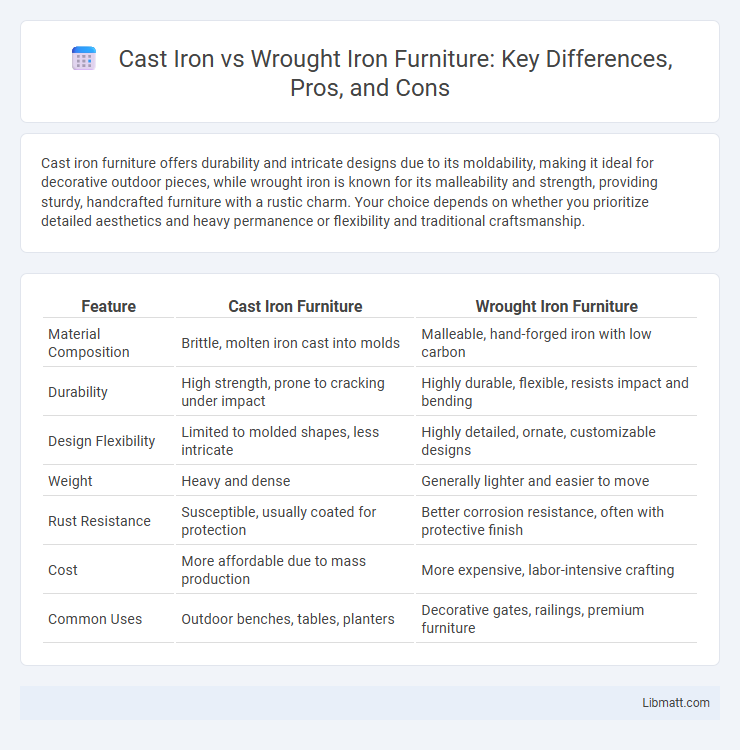Cast iron furniture offers durability and intricate designs due to its moldability, making it ideal for decorative outdoor pieces, while wrought iron is known for its malleability and strength, providing sturdy, handcrafted furniture with a rustic charm. Your choice depends on whether you prioritize detailed aesthetics and heavy permanence or flexibility and traditional craftsmanship.
Table of Comparison
| Feature | Cast Iron Furniture | Wrought Iron Furniture |
|---|---|---|
| Material Composition | Brittle, molten iron cast into molds | Malleable, hand-forged iron with low carbon |
| Durability | High strength, prone to cracking under impact | Highly durable, flexible, resists impact and bending |
| Design Flexibility | Limited to molded shapes, less intricate | Highly detailed, ornate, customizable designs |
| Weight | Heavy and dense | Generally lighter and easier to move |
| Rust Resistance | Susceptible, usually coated for protection | Better corrosion resistance, often with protective finish |
| Cost | More affordable due to mass production | More expensive, labor-intensive crafting |
| Common Uses | Outdoor benches, tables, planters | Decorative gates, railings, premium furniture |
Understanding Cast Iron and Wrought Iron
Cast iron furniture is made from a brittle metal alloy known for its durability and resistance to wear, often featuring intricate designs due to its molding process. Wrought iron furniture, composed of pure iron with very low carbon content, is malleable and typically handcrafted, offering unique decorative patterns and superior flexibility. Understanding the differences helps you choose the right furniture based on strength, maintenance, and aesthetic preferences.
Key Differences in Composition
Cast iron furniture is made from molten iron poured into molds, resulting in a hard, brittle material with high carbon content, typically around 2-4%. Wrought iron furniture contains very low carbon, less than 0.1%, and is forged by heating and hammering, producing a more malleable and ductile metal with a fibrous texture. Understanding these composition differences helps you choose furniture that balances durability with flexibility and aesthetic appeal.
Manufacturing Processes Compared
Cast iron furniture is created by pouring molten iron into molds, allowing for intricate designs and detailed patterns, while wrought iron is forged by heating and manually shaping solid iron bars, resulting in stronger and more durable pieces. The casting process enables mass production with consistent shapes, whereas wrought iron craftsmanship emphasizes customization and artisanal quality. Understanding these manufacturing differences helps you choose furniture that balances aesthetic detail with structural integrity.
Durability and Longevity
Cast iron furniture boasts exceptional durability due to its dense composition, making it highly resistant to wear and able to withstand heavy use over decades. Wrought iron furniture offers superior flexibility and resistance to cracking, allowing it to endure outdoor conditions and physical stress without breaking. Both materials exhibit impressive longevity, but cast iron is more prone to rust if not properly maintained, whereas wrought iron's malleability provides enhanced resilience against environmental damage.
Design Flexibility and Aesthetics
Cast iron furniture offers intricate detailing and elaborate designs due to its ability to be molded into complex shapes, making it ideal for decorative and ornamental pieces. Wrought iron furniture provides superior design flexibility through hand-forging techniques, allowing for customized, artistic, and unique shapes with a more rustic and traditional aesthetic. The choice between cast iron and wrought iron furniture depends on desired visual appeal, with cast iron emphasizing ornate patterns and wrought iron showcasing handcrafted elegance.
Maintenance Requirements
Cast iron furniture demands regular rust prevention through sealing or painting to maintain its durability, as it is prone to corrosion when exposed to moisture. Wrought iron furniture requires routine cleaning and occasional application of protective coatings to prevent rust and maintain its classic aesthetic. You can extend the lifespan of both materials by timely maintenance and protecting them from harsh weather conditions.
Weather Resistance and Outdoor Use
Cast iron furniture offers superior weather resistance due to its dense composition and often protective coatings, making it ideal for outdoor use in various climates. Wrought iron, while durable and malleable, requires regular maintenance such as painting or sealing to prevent rust and corrosion when exposed to moisture. Choosing cast iron furniture ensures long-lasting performance with minimal upkeep, whereas wrought iron offers aesthetic customization but demands ongoing care to withstand outdoor elements.
Weight and Mobility
Cast iron furniture is significantly heavier due to its dense composition, making it less portable and challenging to move without effort. Wrought iron furniture, being forged and less dense, offers greater mobility and ease of rearrangement for outdoor or indoor settings. The weight difference directly affects usability, with wrought iron favored for spaces requiring flexibility in furniture placement.
Cost and Affordability
Cast iron furniture is generally more affordable than wrought iron due to its mass production and lower material costs, making it a budget-friendly choice for outdoor and indoor settings. Wrought iron pieces are often handcrafted, resulting in higher prices that reflect their artisanal quality and durability. Your decision between the two should consider both initial cost and long-term value, as wrought iron tends to offer greater longevity despite its higher upfront investment.
Choosing the Right Iron Furniture for Your Space
Cast iron furniture offers exceptional durability and intricate designs, making it ideal for outdoor spaces exposed to harsh weather conditions. Wrought iron furniture provides a more malleable, lightweight option with elegant, handcrafted details suitable for both indoor and outdoor settings. When choosing the right iron furniture for your space, consider factors like weight, maintenance requirements, and stylistic preferences to ensure lasting beauty and functionality.
cast iron vs wrought iron furniture Infographic

 libmatt.com
libmatt.com